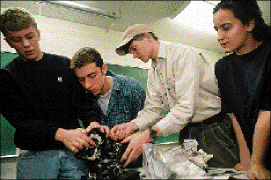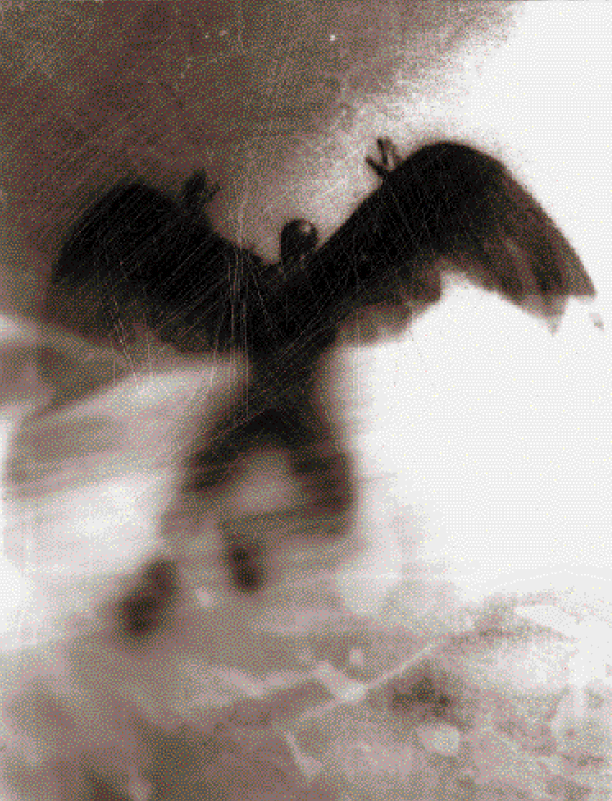In one BYU classroom, students don’t succeed by correctly answering test questions or eloquently arguing a controversial issue. Instead, these students succeed by learning to fly.They call it the Daedalus Project.
It’s 1 p.m., and class in 1127 JKHB has just started. The 17 students take their seats in desks placed randomly around the room while the professors–after welcoming the class–take their seats in desks placed away from the others. At this point, late in the term, they are mainly there to observe. The class leader, Jeremy Anderson, stands at the front of the room, and after a brief introduction, turns the class time to English major Andrea Reese for a 10-minute presentation on stress and strain. Following Reese’s presentation, the class gathers around the desk at the front of the room to watch a display by the engine group. After laying out newspapers sufficient to cover the desk and unwrapping various metal components dripping with black oil, they present to the class the engine of a lawn mower.
Each individual in the engine group has a specific function of the engine to discuss–the spark that gives the engine power, the carburetor, or how gas reaches the engine. As the discussion begins, the hands of the students surrounding the desk go up, and the students begin asking questions and confirming their understanding. The engine group explains by pointing to a specific part or illustrating a concept on the chalkboard. The professors stand quietly on the outside of the circle, occasionally offering comments in the midst of the students’ spirited discussions.

Todd Nelson, Christopher Bender, Allen Martin, and Melissa Brown study the workings of a lawn mower engine. During the course of a semester, students in the Daedalus Project must conceptually create an airplane – including wings, landing gear, engine and bolts.
Just three months ago, Reese couldn’t ask an insightful question about an engine or its inner workings, let alone lead a discussion about the stress and strain equations used to determine the strongest wood for building the structure of an airplane.
Three months ago, Reese and 16 other BYU students walked into their Honors 241 class where they were greeted by Paul Eastman, an associate professor of mechanical engineering; John S. Harris, an emeritus professor of English; and Ray Matheny, an anthropology professor. After getting settled, the students listened dumbfounded as Matheny read a scenario that altered their classroom experience.
In the scenario, the students became students from Greenpeace University in Eureka, Calif., where they were chosen to carry out a special project known as Operation Outlive. The goal of the project, funded by Texas tycoon Rosschild Paroé, was to establish a library in Sitka, Alaska, where critical cultural items and information could be stored when and if the U.S. government failed. To accomplish their task, the students were given an entire library on special microfiche and microfilm that could be read by reflected sunlight. However, on the ferryboat trip to Alaska, the boat sank and the students became shipwrecked on Isla de la Neblina, an undiscovered island about 100 miles from the mainland and surrounded by shark-infested waters. The students found a map left by shipwrecked Spaniards outlining many of the island’s natural resources and, luckily, had access to the microfiche library they took with them.
After the scenario was read, the students were asked to empty their pockets. “These are the only things you have,” Matheny said. The professors then sat down, and the class was left to start figuring out how they would survive, organize their society, and build an airplane to fly off the island.
Naomi Frandsen, a sophomore from La Cañada, Calif., described those first moments as awkward silence. “We were complete strangers. We just looked around and started wondering, ‘What are we supposed to do?'”
That is the problem that faced these students, and it is a problem honors students have faced each fall semester for the last six years.
Harris, who conceived the class concept while in the hospital recovering from an airplane crash, named the class “the Daedalus Project,” after the Greek myth in which Daedalus, a magician, and his son Icarus are imprisoned in a labyrinth of his own making on the island of Crete. To escape, Daedalus fashions wings of bird feathers and beeswax for himself and Icarus. As the two prepare to fly out of the labyrinth and away from the island, Daedalus cautions his son not to fly close to the sun because the wax will melt. Icarus does not listen to the advice, the wax melts, and the boy falls into the sea.
Although Harris did not envision students falling into the shark-infested sea, he did see the class as an opportunity for students to learn about technology. “I saw that if you had a situation where students had to build an airplane from scratch, they would have to get through pretty significant technology to build it.”
Eastman agrees. “This concept of having people start from the very foundations of technology to really understand the simplest things about technology was very appealing,” he says. “If you look at what is required to make an airplane, it’s many of the same fundamentals that allow us to make anything.”
The idea also became appealing to Matheny, who, like Harris and Eastman, has had years of flying experience. In addition, all three professors have had experience building, designing, or repairing airplanes. “Pooling all of our experience together,” Matheny says, “we had a vision of what could be done.”
The class curriculum is, for the most part, dictated by the students and their project, but the professors do provide certain time lines and guidelines for grading. By midterm, the students are required to cover technology up to 1800. The rest of the semester is left to study technology up to the time of the Wright brothers’ invention around 1900. The students have to keep in mind the time line of human history and when various technologies were discovered as well as an island time line–how long after the shipwreck it would take to study and create the technology. In addition, the students go on two field trips: a foundry and a machinery shop.
The students’ assignment the first day was to make a stone tool. They returned the next day with skinned knuckles and an increased respect for cave dwellers. At each stage of development the students have learned, as Matheny says, “that we have no evidence that we are any brighter than our ancestors. We have more things only because we stand on their shoulders.”
By the end of the semester, the class is required to turn in one large book that includes the airplane plans and the research completed throughout the semester as well as models of the airplane and parts of the airplane including the wing and the engine. Teachers grade each student on a personal log of his or her study and feelings as well as research skills, written reports, oral presentations, skills at working with groups, and overall ingenuity in problem solving.
But, beyond grading the students and asking the feared question “Have you considered…” the professors mostly sit on the sidelines. In the early part of the semester, the professors provide more guidance–there are individual tutoring conferences on difficult concepts, coaching sessions on leadership techniques, and hands-on shop assistance with mechanical projects. But toward the end of the class, the professors’ involvement tapers off.
Harris says the professors follow the model used in Arthur C. Clark’s 2001: A Space Odyssey, where humankind is left to its own devices to evolve but is occasionally nudged by extraterrestrial intelligences. “We have modestly assumed the role of those intelligences,” he says. “We present the problem and let the students work toward the solution. We give some hints or prod them to keep on schedule. As necessary, we help them past a few sticky points, but we insist that they use their initiative, and the solution is ultimately theirs.”
“We are very hands-off,” explains Harris, who has retired and will no longer teach the class. “We make them organize themselves and decide how they are going to interact.”
Typically, the class forms into groups. In the fall 1997 class, the students divided into an engine group, a structure group, and a logistics group. These groups had their separate assignments to research and report. For example, the structure group studied wing design and researched the adhesives available on the island to put the airplane together. The logistics group, on the other hand, had to develop the fuel, the tools, and a catapult system for takeoff. Each group, coordinating with the other groups, also had to learn how to develop the resources they would need. If metal was needed, the group had to learn how to locate the ore, mine it, smelt it into metal, forge the metal, and machine it into parts.
In a nutshell, the groups did their research and then worked with everyone in the class to answer the major questions of how to best structure the airplane, how to generate power, what fuel could be used, what tools to use, how to make the tools, how to land safely, and how to make the basic nutsand bolts to put an airplane together. Eastman says these questions really make the students think and work together. “Our world runs on power and is held together by simple things like nuts and bolts and screws,” he says. “We take those things for granted.”
To do their research and study, the students could use the BYU library as well as a collection of more than 100 books provided by the professors. “These books relate to specific things used throughout the course,” Harris says. Some of the books include A Fighting Man of Mars, Prospector’s Field Book and Guide, Papermaking, Manual of Formulas, and a book on cheese making.
The final product, although each class differs in minor details, tends to look like the airplanes of 1910 or 1915, Harris says. He describes the basic plane structure as being made of wood and usually covered in reinforced paper. Also, a catapult is usually used to launch the airplane, and it lands on skids.
As a pilot, Harris says the designs developed by the students look promising. “The semester is not long enough to completely finish, but it is long enough to make the students see that a problem of this kind could be solved if they had sufficient time.”
But Harris feels that the aircraft is not the end objective of the class, anyway. “The end product is an individual who could build an aircraft if they had to or an individual who could solve any large problem when faced with it.”
For many students who enroll in the class, this challenge is one that takes them out of their element. In fall 1997, one student was an electrical engineering major, and two studentswere computer science majors. Those three students were the limits of the technical background in the class, and many of the other 14 students described themselves as “technophobes.”
“My first impression was what a tough time we were going to have with not very many technical people in the class,” says class leader Anderson, a senior majoring in electrical engineering. “But many of the students put their shoulder to the wheel and learned about technology.”
Because of this situation, Anderson says the class is focused on more than just technology. “In here, you learn about learning–the method of learning.”
Eastman says this learning process is one of the real benefits of the class. “The students come away from this realizing that they’re capable of understanding their world. They can learn things, and they can understand them,” he says. “We’ve put them in a position to open their eyes to things that should have happened long ago in their education.”
Frandsen, an English major who signed up for the class just because it fit into her schedule, says she had an eye-opening experience. “Before I took the class, I didn’t know how an engine worked, computers were a mystery, and basic mechanical things were above me. But since we were forced to theoretically make everything, I was forced to answer questions, and I feel like I now can look at something and see how the different parts fit and work together.” By the end of the semester, Frandsen, a member of the logistics group, was building a model of the pulley system that would be used to launch their completed aircraft.
The professors have also learned that in addition to being a class on learning technology, the Daedalus Project has become a sociological experiment as well. Since the students need a government or some type of leadership to survive on the island for the time it would take to construct their aircraft, a leader is the first thing the groups usually choose. But, Eastman says, it’s interesting to see how the classes deal with this decision. “When it comes to organizing themselves–deciding what kind of social structure or governmental structure they are going to have–that’s often the most difficult thing they have to do,” Eastman says.
Anderson, who volunteered like many class leaders in the past have done, says he learned some different lessons as a result. “I learned more about people skills, organization, and delegation than I ever thought I would learn.” Anderson, along with English major Marc Shaw, will be presenting a paper about the Daedalus Project at the National Honors Symposium in Albuquerque, N.M., in April.
The unstructured nature of the class forces the students to learn a wide variety of subjects and skills; it becomes one of the greatest benefits of the experience, Eastman says. “Each class has done it differently.”
For example, Eastman points out the experience the first Daedalus class had in contrast with a class a few years later. The first class, in order to organize their society and get to know each other better, had a “lock in” in Eastman’s basement. “They began to know each other and started to trust each other,” he says. A few years later, however, there was a Hagoth faction (named after the Book of Mormon group that went to explore the land Northward). A part of the class was not happy with how the class was organizing itself and decided to move to the other side of the island. “It becomes quite real,” Eastman says.
Harris quips with a wry smile, “They’ve ranged all the way from Gilligan’s Island to Lord of the Flies.”
Despite the varied approaches of the different classes, the students’ reactions are the same, Eastman says. “Students who have taken this class over the years come up to me and say, ‘You know, that was the best class I ever had. It changed my life. I look at the whole world differently now.'”










